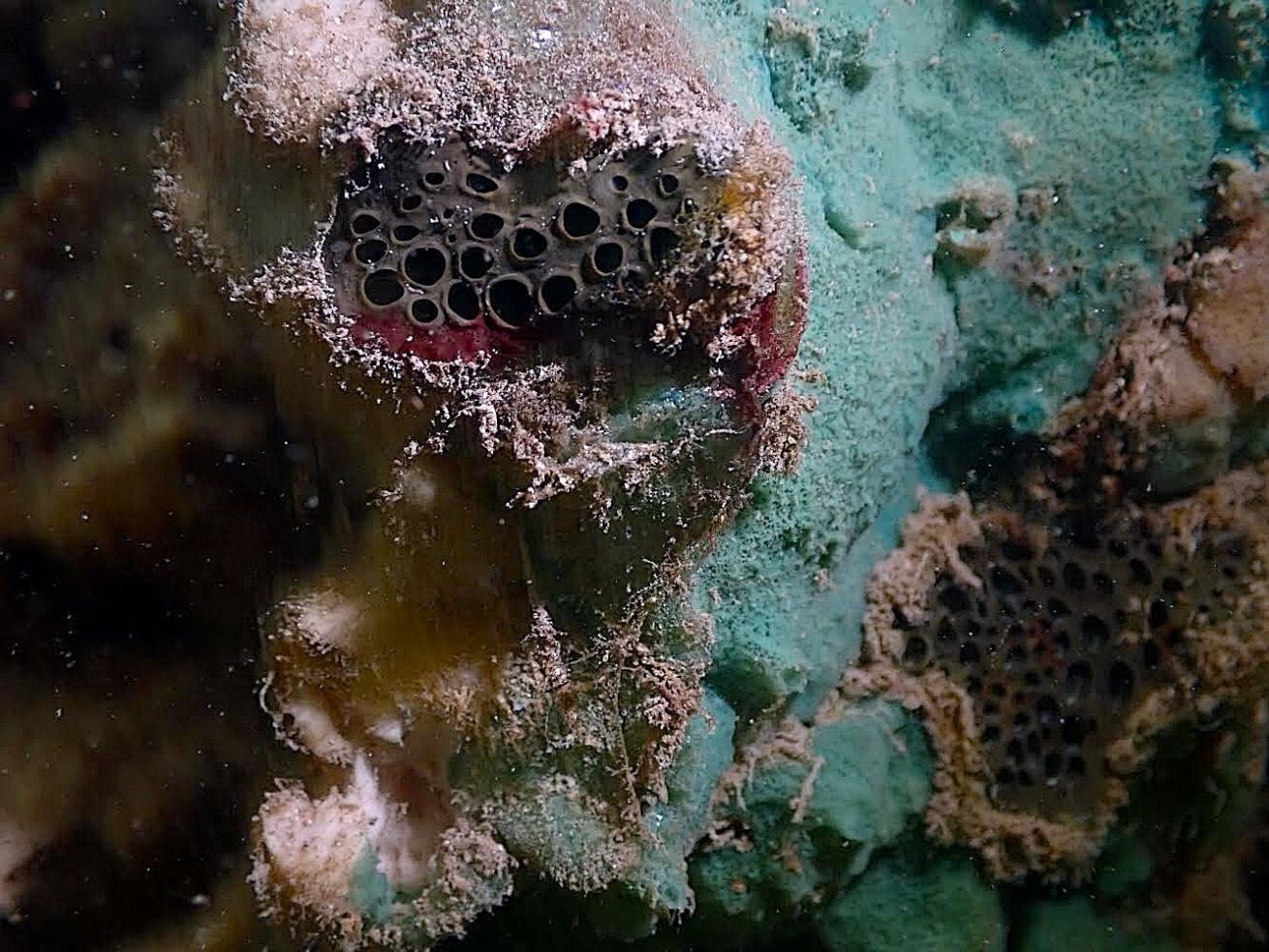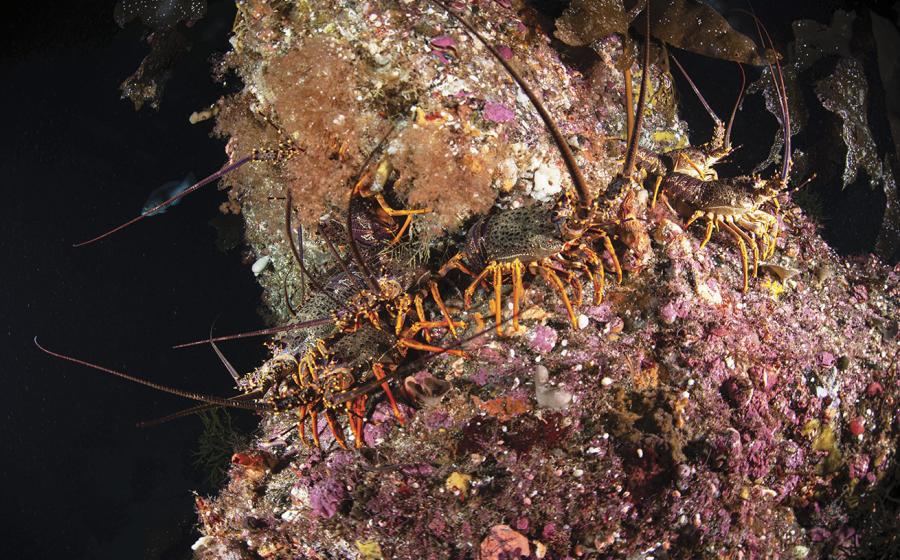3 Nearshore Habitats to Dive

Rachel PlunkettSeahorses can often be spotted holding onto blades of algae or seagrass with their tails for stabilization.
When most people think of scuba diving, they imagine the vast, deep blue open ocean, a tropical coral reef or perhaps a jungle-like kelp forest. While those more commonly explored waters certainly have their magic, nearshore dives offer a unique and captivating experience that's not to be missed. Here, in the shallows, you'll discover a world brimming with life—seagrasses swaying gently, mangroves standing firm and providing shelter, and sponge flats teeming with tiny wonders.
Habitat Connections
Each of the nearshore habitats mentioned here may seem like they are separate entities, but they're all intricately connected, serving as nurseries and feeding grounds for a variety of marine life. Separate patches of habitat can be connected by narrow “wildlife corridors” that allow animals to move from habitat to habitat. Each of these habitats play a crucial role in supporting the health and diversity of nearby coral reefs and are also really cool places to explore on your next dive trip.
Understanding how these different habitats are connected to each other and how fishes, marine mammals, seabirds and sea turtles use them helps resource managers make better decisions when it comes to coral reef conservation or protecting certain migratory species.
Not only do researchers benefit from learning about these various habitats that support keystone species and coral reef ecosystems, but recreational scuba divers can also expand their knowledge and appreciation of the ocean by exploring and learning about these unique yet connected nearshore ecosystems.

Rachel PlunkettThe red mangrove (Rhizopora mangle) has a dense tangle of roots and plays an important role in shoreline stabilization.
Mangroves
Mangroves are nature's superheroes of the coast. With their complex root systems, they stabilize shorelines, trap sediments and provide a safe haven for juvenile fish and other marine creatures. Their aerial roots are perfect hideouts for small critters like crabs and shrimps, while larger fish and lobsters seek refuge among their submerged roots. As mangroves filter water through their roots, they also help improve water quality, making them essential cleaners of coastal ecosystems.
In many mangrove habitats, you’ll notice a lot of growth on the underwater prop roots. There might be heavy mats of algae mixed with beautifully colored sponges and tunicates. Look closely and see if you can spot some different species that call mangrove roots home.
Mangrove Systems to Check Out
- Florida, USA: Along the outskirts of Biscayne Bay or in the backcountry of Florida Keys National Marine Sanctuary and Everglades National Park.
- Belize: Along the mangrove-fringed shorelines of Belize (such as Hol Chan Marine Reserve)
- U.S. Virgin Islands: In the mangrove lagoons of the Virgin Islands, such as at Hurricane Hole and Mary Creek
Related Reading: The Newest Marine Sanctuary Beckons Wreck Divers to Explore the Great Lakes
Rachel PlunkettTurtle grass (Thalassia testudinum) is a species of seagrass found throughout Florida and the Caribbean that can form thick meadows.
Seagrass
Seagrass meadows may appear as simple green carpets beneath the waves, but they're bustling hubs of activity. These underwater fields of grass provide food and shelter for a plethora of marine life, from tiny seahorses and juvenile fish to sea stars, conchs and grazing sea turtles and manatees.
Not only are seagrass meadows an underwater hotspot for marine life, they also stabilize sediment, help improve water quality and play an important role in recycling nutrients throughout ocean ecosystems.
Seagrasses also play a role in carbon sequestration, helping to combat climate change by storing carbon in their root systems. Their importance in maintaining healthy marine ecosystems cannot be overstated.
When diving in seagrass habitats you can gently glide just above the blades, searching for marine life that hide in between or live epi-biotically on top of the blades. You may spot stingrays and ground sharks swimming gracefully through as they search for food, find a tiny and brightly colored nudibranch on a seagrass blade or you might spot a pipefish or a seahorse pretending to be a piece of drift algae.
There are also lots of critters found in the sand within seagrass habitats, such as anemones, tube worms and mantis shrimp. There are several species of octopus and cuttlefish that like to inhabit grassy bottoms, so these areas can be a great place to brush up on your octopus photography skills.
Some of the best places to explore shallow seagrass communities include:
- The Bahamas: The Bahamas is home to some of the healthiest and most expansive seagrass meadows in the Caribbean. In places like Exuma Cays and the Andros Island North and South Marine Park, you'll find large seagrass beds that are rich in marine life, including sea turtles, manatees, stingrays, and sea stars.
- Florida Keys National Marine Sanctuary, USA: The Florida Keys boast diverse marine ecosystems, including contiguous seagrass habitats around islands like Key Largo and Islamorada. These meadows are great for snorkeling, and you may encounter creatures like nurse sharks, pufferfish, pipefish, seahorses, conches and nudibranchs.
- Moreton Bay, Australia: Moreton Bay, near Brisbane, is home to vast seagrass meadows. You can snorkel in areas like Tangalooma and North Stradbroke Island, where you may see dugongs, sea turtles, and various fish species.
Related Reading: Why Do Sea Turtles Return to the Same Beach?

Rachel PlunkettLook closely on the surface of marine sponges and you might spot a small nudibranch like this lettuce sea slug (Elysia crispata).
Sponge Grounds
Sponge grounds are one of the most underrated marine habitats in my opinion, and while they may not be as popular as coral reefs, they are fascinating in their own right. These shallow hardbottom areas are home to a diverse array of marine sponges that come in a variety of shapes, sizes and colors.
From encrusting sponges that decorate the seafloor and rocks to vase-shaped sponges that stand tall like underwater skyscrapers, each sponge plays a part in providing important structure and habitat for wildlife.
Commonly, you will see ball, globular, vase, and rope-shaped sponges in shallow, tropical sponge flats, which often harbor a plethora of critters living within their canals such as amphipods, snapping shrimp, brittle stars and even baby lobsters. These flats are also frequented by a variety of commercially and recreationally important fish, creating a vibrant and bustling underwater neighborhood.
Ready to get a closer look at some fascinating sponge grounds to explore?
- Champagne Reef, Dominica: Champagne Reef, with bubbling waters that rise from thermal underwater springs, is rich with colorful coral and sponge formations, and home to many unusual marine species, including frogfish and seahorses. There you can find an array of sponges such as pink azure, red rope, yellow tube, and purple vase.
- Aegean Sea: The small island of Kalymnos in Greece is renowned as the center of the Greek sponge diving industry. There are thousands of species of sea sponges here, including natural sponges sold commercially from the Aegean sea: honeycomb sponge, matapas sponge, vase sponge, elephant ears sponge, and leathery sponge.
- Florida, The Bahamas and the Caribbean: The shallow hard-bottom habitats throughout the tropical Western Atlantic contain an incredible diversity of marine sponges. There are many shallow sponge flat locations accessible via a shore dive, kayak, dinghy, or other shallow draft vessel. These are excellent nursery grounds for baby lobsters and other juvenile critters. Explore with care.
Related Reading: Diving in Greece: Three Unexpected Islands to Visit

Rachel PlunkettThese sponges are growing on a mangrove root. The large excurrent openings of marine sponges (osculum) are great spots for tiny snapping shrimp, brittle stars, and amphipods to live.
The Patient Explorer
Nearshore diving is a different experience compared to venturing into the open ocean. The key is to move slowly and observe closely. By taking your time and paying attention to your surroundings, you'll be rewarded with sightings of some truly remarkable marine life.
Unlike the open ocean, where visibility can stretch over 100 feet, nearshore environments can be murkier, but don't let that deter you. Instead of covering large distances, focus on exploring smaller areas in detail.
Look out for camouflaged critters blending into their surroundings or tiny nudibranchs making their way across the seafloor. The more you observe, the more you'll discover the hidden treasures of the shallows.
Practical Tips for Nearshore Diving: Embracing a Responsible Approach
Exploring nearshore habitats comes with a responsibility to tread lightly and minimize our impact on these fragile ecosystems. Here are some practical tips to help you dive responsibly:
1. Good Buoyancy
Maintaining good buoyancy control is essential to avoid damaging delicate habitats. Practice buoyancy skills regularly to ensure you're neither sinking into the seafloor and disturbing the tiny hiding holes of octopuses, fish and crabs, nor silting out the water above.
This is especially important in areas with delicate seagrass, and it is important that you take caution not to scour out seagrass root systems by dredging into the bottom as a result of bad buoyancy. This can cause scarring in the seagrass bed that can take years to heal.
2. Fin Kicks
Use gentle fin kicks to move through the water, minimizing sediment disturbance. Modified flutter kicks or frog kicks are great techniques to propel yourself forward without stirring up the seafloor.
3. Safety First
Always plan your dive ahead of time and follow your dive plan. Check local tide tables and currents before entering the water. Be aware of potential hazards like sharp rocks, ghost fishing gear or strong currents, and always dive within your limits.
4. Water Entry and Exit
When entering and exiting the water, use designated entry points whenever possible to avoid trampling on fragile habitats. If you need to navigate over seagrass or sponge flats, take care to step lightly and avoid causing unnecessary damage. When entering into gradually sloped shallow environments, you can sometimes inflate your BCD without putting it on and swim out to deeper water using gentle frog kicks. Once you reach water that is a bit deeper, you can don your scuba gear and start your dive.
By following these tips and adopting a mindful approach to nearshore diving, you can enjoy the beauty of these unique habitats while helping to preserve them for the wildlife that depend on them and for future generations of divers to explore and appreciate.










